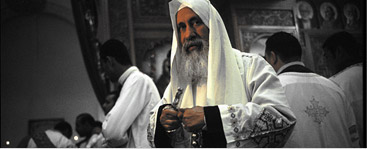
Erik Hornung, through an examination of Egyptian texts across a wide range of history, supported that the Copts continued to employ “enter”—the plural version of the Egyptian word for “god,” as opposed to the singular “noute”—in a variety of contexts, including spells and personal names. He observed that only Akhenaton tried to erase this plural usage. But then Christianity itself looks less monotheistic when one adds into the picture the Virgin Mary, and countless saints, angels, and demons, not so radically different from Egyptian practice to elevate a local god over the pantheon as a whole, a tendency exacerbated by the growth of cults focusing on single gods in the Greco‑Roman period.
Coptic Christianity shared some other similarities in doctrine with the old Egyptian religion which undoubtedly facilitated conversion. Joseph Campbell, among others, remarked that “the antique model for the Madonna, actually is Isis with Horus at her breast.” The characters in the Isis‑Osiris‑Horus myth, which dates back to at least the third millennium BC, did not directly correspond with the Biblical account of the resurrection of Christ, but they did embody a strikingly similar concept. Osiris was murdered by his evil brother Set but resurrected by the love of Isis, forming the justification for the intricate mummification process and Egyptian burial with a wide range of earthly belongings. The spirit, or “ka,” was reborn after death in a mystical afterlife which the resurrection of Osiris made possible. Osiris, who appeared bound like a mummy, oversaw the weighing of the heart of the deceased in an effort to assess the extent of his wrongdoings in life. Thus, Egyptian religion, like Christianity, supported that exemplary behavior was necessary before one could unite with God in the afterlife and that good behavior was the path to ultimate happiness. Furthermore, the Isis‑Osiris myth included a divine birth because Isis conceived baby Horus while Osiris was still dead.
Such similarities between Christianity and the old religion could be expected because new religions do not rise up out of an ideological void. Both belief systems had their source in the Middle East, and these basic ideas also were present in other religions that had sprung up in the region. Many scholars have suggested that the inspiration for resurrection myths may be found in ancient observations of the annual cycle of the seasons. Numerous studies have confirmed that aspects of the Old and New Testaments and Christian wisdom literature were derived from Egyptian beliefs.
A more intellectually‑minded Christian might support that these linkages were more apparent than actual, but on a practical level, the Egyptian peasant would not make such distinctions. He would only recognize that the general concepts were not radical departures from his already‑established view of the world.
Finally, as noted previously, Christianity offered to the Egyptian what his old religion did not: imminent salvation from the cruel masters. This point of departure may explain, for example, the breakdown of mummification after Christianity became predominant. The replacement of a material view of the after‑life, which necessitated that the body be preserved and be buried accompanied by objects needed for the afterlife (which was not all that conceptually different from the primary life), with a more “spiritual” one meant that mummification was no longer needed. While archaeological findings support that mummification died out only gradually, the extent of accompanying burial goods rapidly decreased. Interestingly, some people were buried along with baskets and jars containing consecrated bread and wine from the Eucharist perhaps to succor the soul as food and drink literally had been needed for the nourishment of the resurrected dead in the past. But with the imminent Golden Age on the threshold, what need was there to waste energy preparing for the afterlife?

What actually happened next was not the overthrow of the Roman dictator—the Byzantine (Eastern) Roman Empire continued to rule Egypt until the Arab Conquest—but the routinization of Christianity. Also interesting was the predominance in Egypt of Gnosticism, a form of Christianity which mainstream, orthodox Christianity labeled as heretical, but that merits another discussion. Ultimately, the transition from the old Gods to Christianity cleared the path for the rapid conversion of Egypt to another salvation religion just a few centuries later. Unlike Christianity, Islam promised a final and total rejection of Greco‑Roman domination and worldview and would become the predominant religion in Egypt for nearly 1,500 years and counting.






